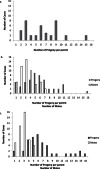Genetic analysis of captive spawning strategies for the endangered Rio Grande Silvery Minnow
- PMID: 23519867
- PMCID: PMC3695603
- DOI: 10.1093/jhered/est013
Genetic analysis of captive spawning strategies for the endangered Rio Grande Silvery Minnow
Abstract
Captive breeding and rearing are central elements in conservation, management, and recovery planning for many endangered species including Rio Grande Silvery Minnow, a North American freshwater cyprinid. Traditionally, the sole purpose of hatcheries was to produce as many fish as feasible for stocking and harvest. Production quotas are also an important consideration in hatchery programs for endangered species, but they must also maintain and maximize genetic diversity of fish produced through implementation of best breeding practices. Here, we assessed genetic outcomes and measures of productivity (number of eggs and larval viability) for three replicates of three mating designs that are used for this small, pelagic-spawning fish. These were 1) monogamous mating, 2) hormone-induced communal spawning, and 3) environmentally cued communal spawning. A total of 180 broodstock and 450 progeny were genotyped. Genetic diversity and egg productivity did not differ significantly among spawning designs (H e : F = 0.52, P = 0.67; H o : F = 0.12, P = 0.89; number of eggs: F = 3.59, P = 0.09), and there was evidence for variance in reproductive success among individuals in all three designs. Allelic richness declined from the broodstock to progeny generation in all breeding designs. There was no significant difference in the genetic effective size (regardless of the method used) among designs. Significantly more viable eggs were produced in environmentally cued communal spawn compared to the alternative strategies (F = 5.72, P = 0.04), but this strategy is the most difficult to implement.
Figures
References
-
- Andersson M. 1994. Sexual selection. Princeton (NJ): Princeton University Press;
-
- Araki H, Cooper B, Blouin MS. 2007. Genetic effects of captive breeding cause a rapid, cumulative fitness decline in the wild. Science. 318: 100–103 - PubMed
-
- Ballou JD. 1984. Strategies for maintaining genetic diversity in captive populations through reproductive technology. Zoo Biol. 3: 311–323
-
- Bestgen KR, Platania SP. 1991. Status and conservation of the Rio Grande Silvery Minnow, Hybognathus amarus . Southwest Nat. 36: 225–232
-
- Bottrell CE, Ingersol RH, Jones RW. 1964. Notes on the embryology, early development, and behavior of Hybopsis aestivalis tetranemus (Gilbert). T Am Microsc Soc. 83: 391–399
Publication types
MeSH terms
Grants and funding
LinkOut - more resources
Full Text Sources
Other Literature Sources



